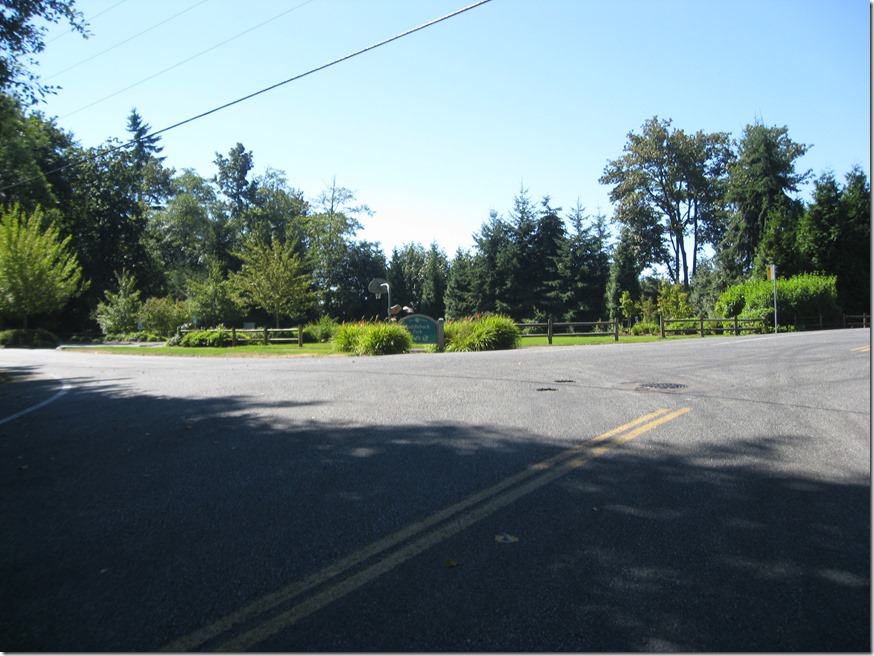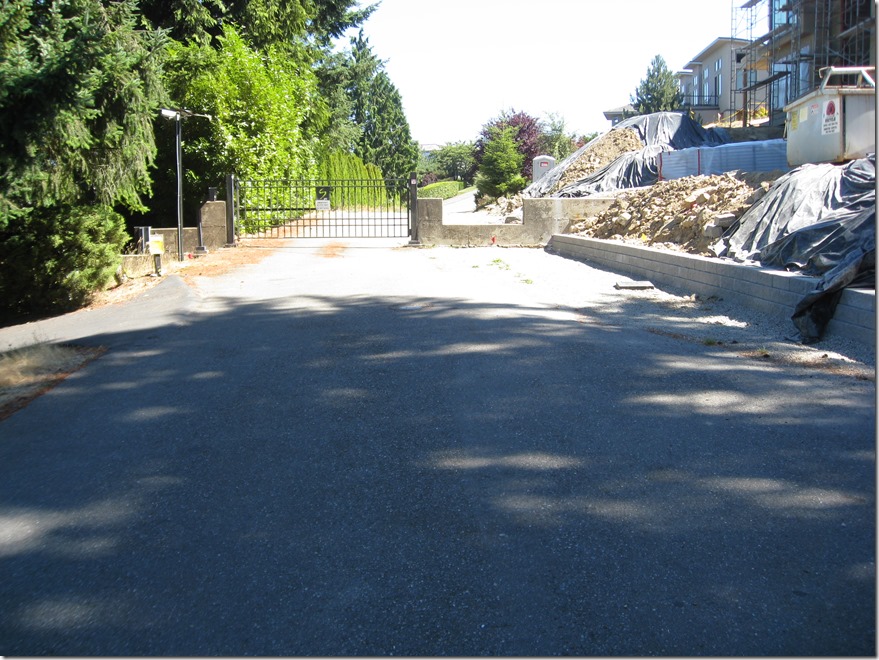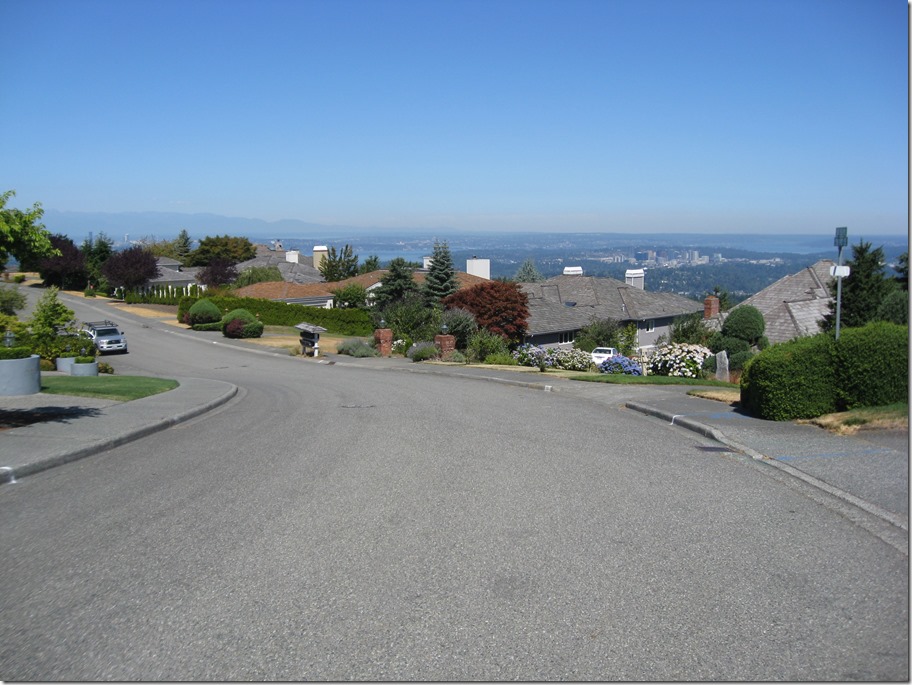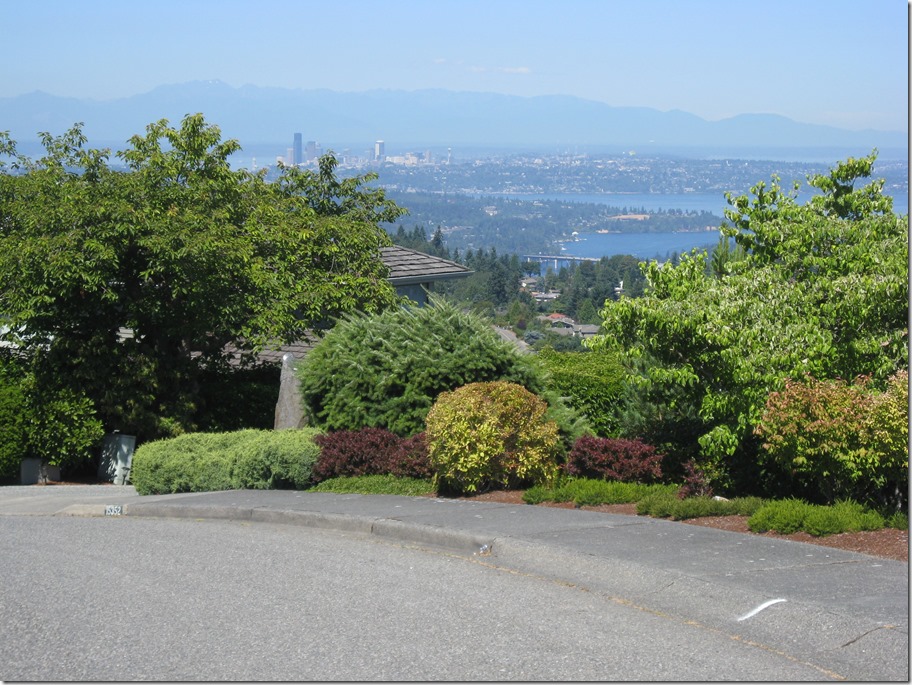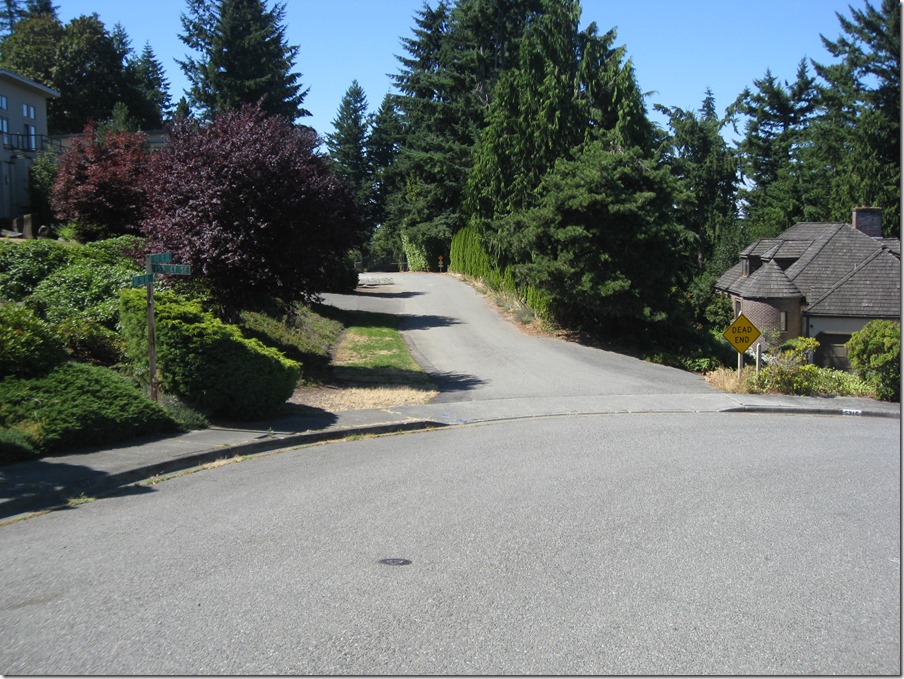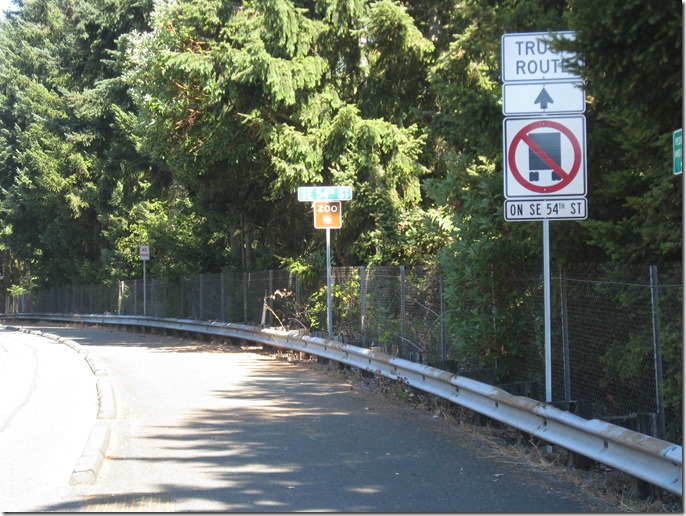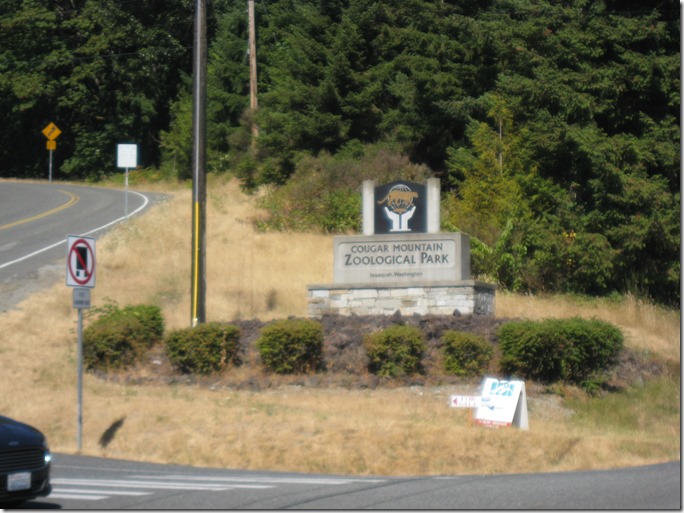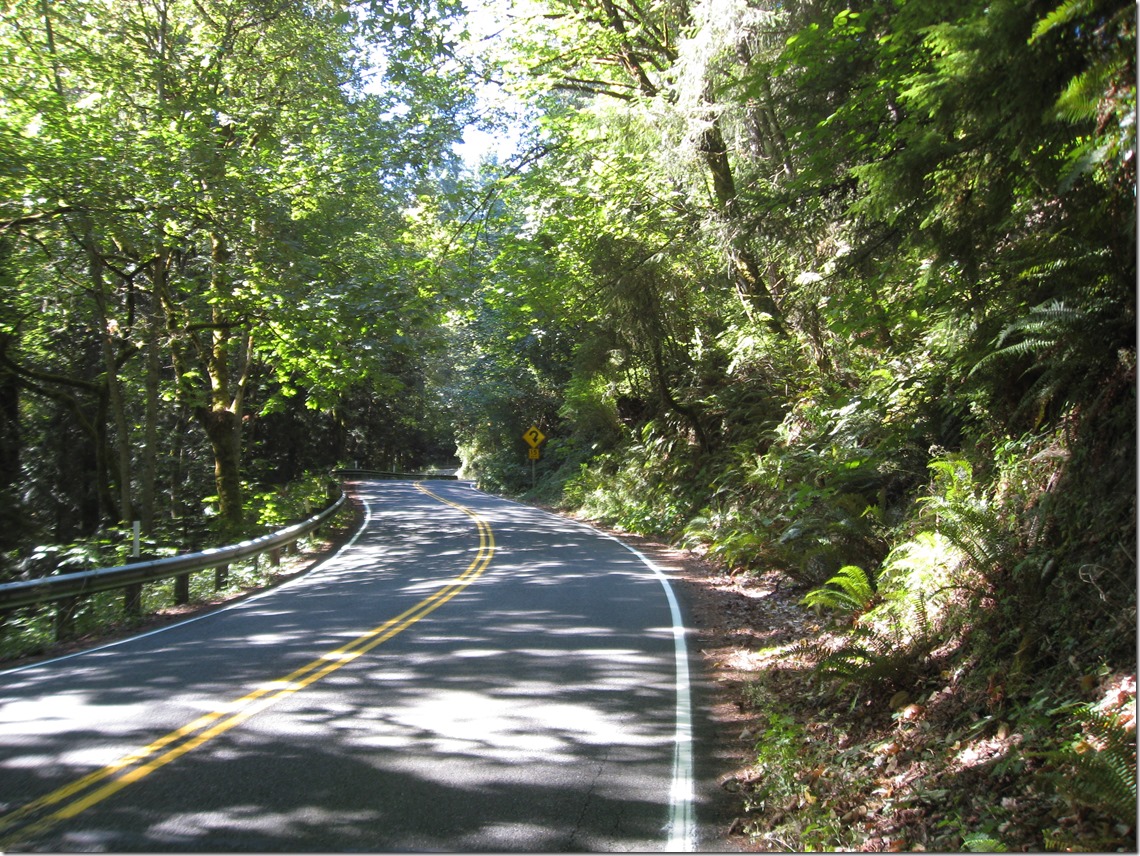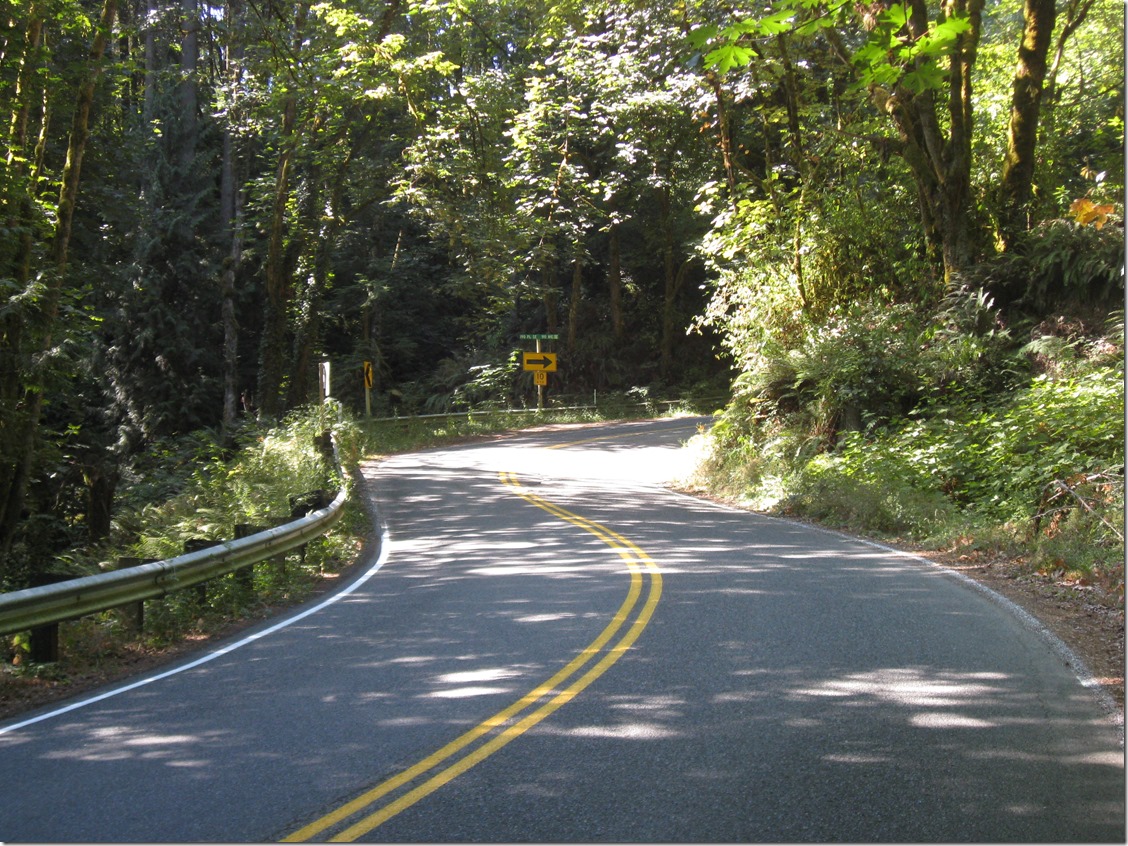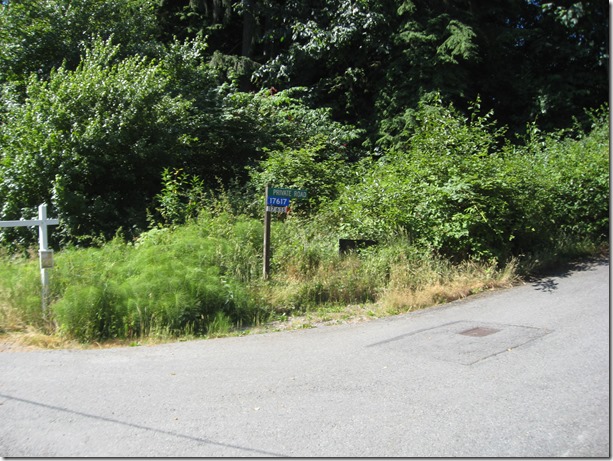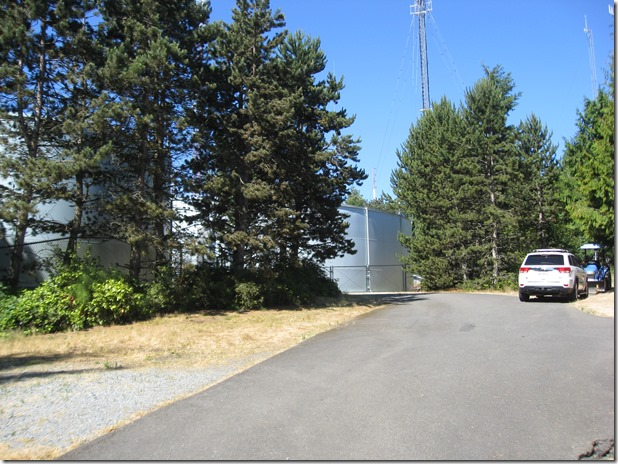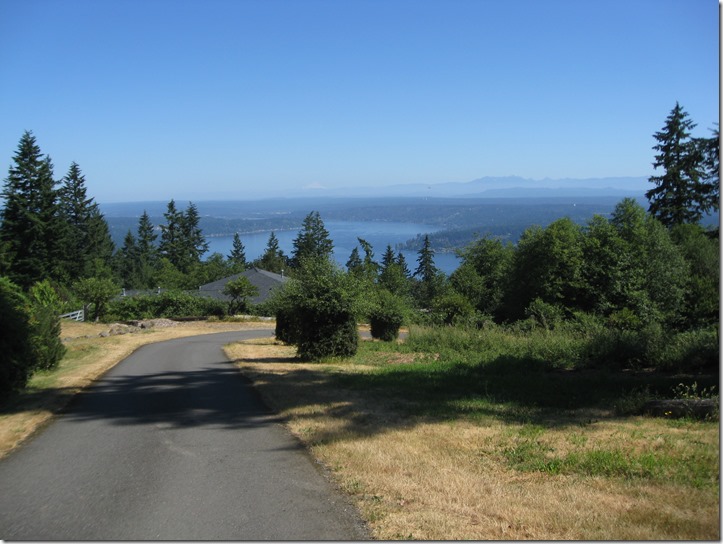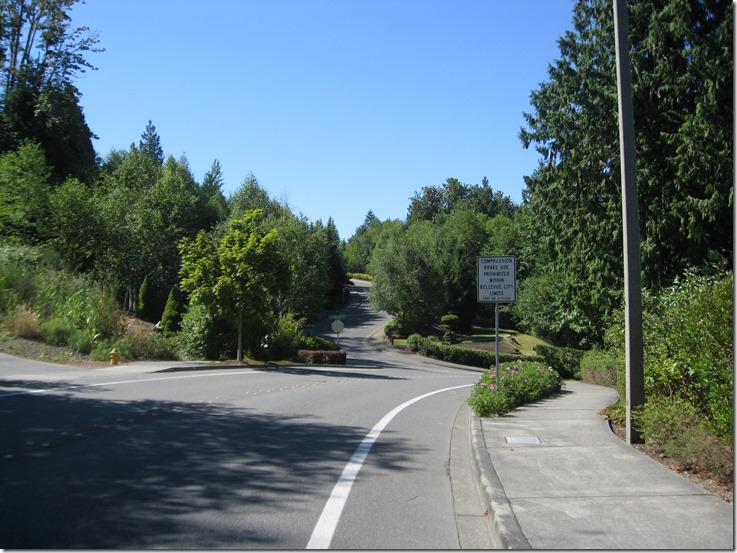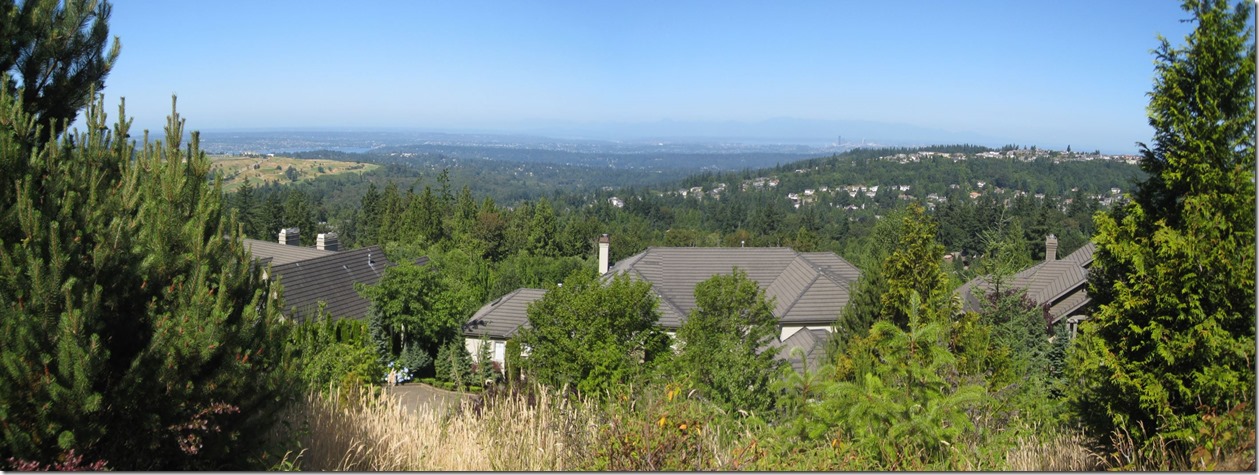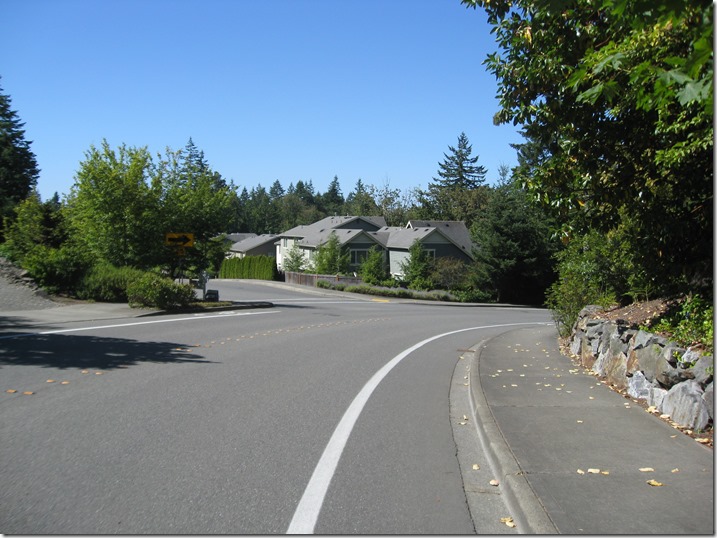The offspring is starting her senior year of college this fall, and it’s seems likely that her ability to do things with us will be more constrained in the future, so we decided to do a nice family vacation. Going to the Big Island of Hawaii has been on our list for a while, so we chose to go on a Hawaii Big Island Family Multisport Tour for older kids, or something like that – all families, all with kids, but at least one kid needs to be 17.
And, to get something out of the way up front, I was sorry that I was in Hawaii and didn’t get a chance to climb Haleakala (10,0000’), because they have inconsiderately decided to place it on Maui. I looked up some information on riding to the top of Mauna Kea – which houses a lot of observatories because it tops out at 13,700’ or so – but it is not paved at the top, the ride is purported to be very hard, and the point of going is to be on a *vacation* with my *family*.
We flew Alaska from Seattle directly to Kona International Airport, where we deplaned, got our luggage (no bikes – we will rent), and grabbed our shuttle to the Waikola Beach Marriott Resort & Spa. It took a bit longer than that – shuttles always take a bit of extra waiting, and as soon as you go to Hawaii, you are on island time, so you need a relaxed attitude. Luckily, we had no place we had to be on the first day, so we just kicked back and tried to relax.
I’m am mostly on vacation to either get out and do things or sit around and relax; I’m not really into the resort side of things, and I’m pretty tired, so I mostly just sat around. I think Kim and Sam went shopping. Dinner was at The Three Fat Pigs, which was pretty good, though there were two strange occurrences; when we showed up at 5PM (8PM Seattle time, so we were hungry), we were told that we were lucky to get in because they were almost all booked. This was strange because only one of 30 tables was occupied at the time, and they never hit more than about 75% full while we were there. The second was a distinct lack of condiments on the tables. But, other than that, it was close to the hotel, casual, and we got back in time to watch the sunset.

The Waikola is fine; nice pool, and a nice beach that is set away from the hotel a bit. And, you can walk to the King’s shops or the Queen’s shops, which takes you to non-resort food and other stuff, which is nice.
The next morning, we were up early to eat and get picked up by Backroads, our tour company. Breakfast was something that we picked up at the aforementioned stores the night before.
We meet one of the other families while we wait for the van. Then we get our luggage to the van, meet our tour leaders. Rob and Lora will be the main leads, and Reggie will be the support driver who spends a lot of time doing behind-the-scenes work. We pile into the van, and head down the road to pick up the other two families. That goes quickly enough, and we head to our first spot.
I should perhaps say a bit more about what this trip is like. Guided tours run the gamut from hardcore tours where you ride a bunch every day and tours that have a small amount of riding every day to multisport tours like this one where you ride some most days but also do other activities. There are generally two or three distance options for the ride each day, and this can often be modified if you want more or less difficulty.
Day 1: Waipio Valley
The van drops us off at the processing and retail outlet for Ahualoa Farms, a very tiny macadamia nut company in the town of Honoka’a. We go and listen to a discussion about how the nuts are prepared and eat some samples while our leaders pull bikes off the vans, put on our pedals, and generally get everything set up. After a bit of bike adjustment, we stock our Ziploc bags from the treat table (too much sugar, not enough salt) and pull out on a out-and-back ride before lunch.
The three of us have different riding abilities and tolerances; Kim does a fair bit of exercise and rides to work in Bothell and back now and then, and Samantha hasn’t been on a bike for years. My plan is to sometimes ride with one or more of them and sometimes to ride by myself. We start out as a family.
It is hottish (we are on the wet side of the island), but the heat doesn’t bother me very much – it’s been pretty hot at home this summer and I’ve ridden in it a fair bit. However, at home, we think it’s humid when it hits 25% in the summer, and Hawaii averages 70-80% during August. And hurricane tropical depression Guillermo has been sending extra moisture this way, so the actual humidity is around 250%.
But, we’re riding together and the scenery is beautiful, so we keep riding, eventually reaching a overlook of the Waipio valley. I walk carefully down a really step path in my cleats to reach the edge.

This is a very crenelated section of coastline, with deep valleys that lead far back into the interior. There’s no easy access, though you can get down to the beach if you have a serious 4×4.
I ran into these two ladies and they agreed to let me take their picture.

After a few minutes there, we turn around and head back. We’re a bit slow because Sam’s getting her bike legs back. Somewhere in this section, one of the father & son pairs passes us, and a few minutes later, Sam says something like, “go chase them down and show them who’s in charge for me”.
So, I put my head down and chased. It was… uncomfortable; my heartrate went from averaging 88 BPM before I chased to 150 BPM for the remaining 5 miles. It’s hot and humid and there’s a 300’ climb in it, but I’m decent at suffering so I hold on and arrive back at our start.
Part of the reason I rode that way is that the longer option for the day was scrubbed due to some fallen logs from a recent storm, so I’d only be riding 20 miles for the day.
Samantha rolls in about 10 minutes later, the benefit of a “bump”. A bump is where you stop before a tough part, they toss your bike on the van and then drive you to the top. This is a great way to extend your riding ability and annoy your father.
Lunch is a typical backroads lunch; there’s some kind of meat (pulled pork IIRC), a few different salads, bread, some fruit (pineapple + mango), and various drinks. Their lunches have variety, it’s easy to find something healthy to eat, and the food is always tasty.
After lunch, we pack into the vans to drive up the coast to ‘Akaka Falls State Park. It is, of course, hot and humid, but we walk on the walkway – because that’s what one does – to reach the overlook.

That’s 422’ of splendor. The walkway continues down so you can get a viewpoint of Kahuna falls, which, frankly isn’t worth the extra effort. But I did find this little feller on our walk out:

We finished the day with a trip up from Hilo to Volcano Town.
It’s a town! On a volcano!
Okay, so, technically, every town in Hawaii is on a volcano, but this is up high – at about 3800’ – and very near to the Kilauea Visitor center. We are staying in the Kilauea Lodge & Restaurant – well, technically, we are pretty much taking it over; by my count we have 9 of 11 rooms occupied. The lodge was built as a YMCA camp back in 1938, and is rustic in a good way. There is no TV but there is internet.
We have dinner that night in the restaurant. The apps are okay, but my Ahi is pretty tasteless. Probably the low point of our culinary experiences.
Strava. 20.2 miles, 1128’ of climbing.
Day 2: Volcano Day!
This is a multi-sport day. After a hearty but slow breakfast at the restaurant in the lodge, we van up and head to the visitor’s center (technically, Hawai’i Volcanos National Park), where we meet up with Tim, our guide for the day. We first walk out to a viewpoint, where – if I’m remembering the geology correctly – we can see the whole caldera (the part that filled with lava at one time), and then, in the middle, the steaming crater.

Perhaps this view will help:

You can see the edges of the caldera and the obvious crater. The previous picture is from the white buildings in the upper right. The caldera is about 2 miles by 1.5 miles
To the right you see a small crater called Kilauea Iki, which means “little Kilauea”. Back in 1959, it was the site of a pretty spectacular eruption, with lava fountains reaching 600 meters (1800’ in freedom units) high. The crater filled with lava, which then drained back after the event. There’s some cool film of it here.
We start with a climb down into the crater, which is mostly on a well-paved path, losing around 400’. We reach the floor:

The hill to the right was formed from the lava fountain; it’s around 600’ high. The far edge of the caldera is about 1.5 miles away. In the distance, you can see a lake. A lake… of LAVA. Well, cooled lava, anyway. That’s where we’re going.
Here’s a better view of the hill:

I have helpfully inserted some people to give you a sense of scale. The lava here is pretty jumbled and sharp, which is pretty common for island lava.
Here is a photo of the group:

We make our way to one of the vent holes for the eruption (daughter provide for scale):

At this point, we have reached the edge of the part where the caldera was full of molten lava. When the eruption finished , the lava cooled and the top few inches solidified. Then, a bunch of the lava beneath drained away, and when that happened, the top fractured as it dropped:

Looks very much like torn-up asphalt roadway. We keep walking more, and we get to a section where the lava cooled differently, and the surface gets much smoother. We can see our vans parked up at the top of the caldera wall.

As we reach the other end, we turn and look back:

Then it’s a series of switchbacks up and out of the crater to the road, and then across the road to Thurston Lava Tube. It’s a tube in the ground, it’s okay, but not close to as impressive as the crater we were just in.
Then it’s back in the vans to the lodge, where we have a nice lunch. And then, to the bikes! There are 3 options; a ride back into the park to a different overlook and back, a ride to the overlook and then down to a overlook of the ocean, and the ride down to the overlook and back. I would leave you in suspense as to which on I was planning on doing, but I think you will figure that out on your own.
We ride off into a heavy mist, the remnants of Guillermo. I stick with the family on the way to the overlook, and as we leave to head towards the overlook, it starts to rain, at which point I remark, “I don’t know about you but I am experiencing *the hell* out of this national park”.
We continue on as the weather switches back to on-and-off drizzle, which normally would be annoying, but since it’s 70 degrees it’s fine. We hit the turnoff to head down to the overlook, which is named Halina Pali. It’s a very minimal barely 1.5 lane road that winds up, down, and around the terrain the whole way down. It’s sort of a fun descent though you can’t get a lot of speed on it because you can’t see what’s ahead very well. We spend about 40 minutes on the 9.6 mile descent, and finally pull into the overlook, which looks like this:
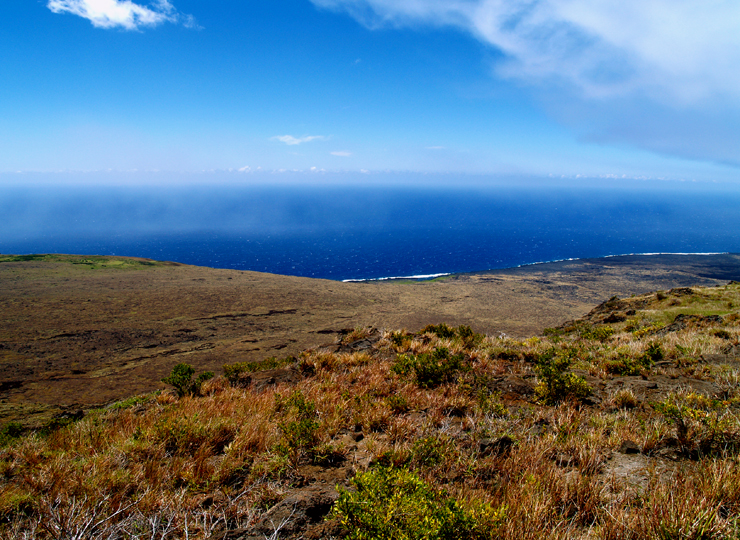
Theoretically. What we see is this:


A quick picture of me, I refill my bottles, stuff my vest back in my jersey pocket, and head out on the climb back. I am not surprisingly the only one who thinks a 1600’ climb in the mist and rain is a great idea.
In the first few minutes, I meet the remainder of the group who is riding down to the overlook. As soon as the group finishes wandering around and the bikes are loaded, they’re going to be heading back up.
I have a goal. It’s to finish the climb from the overlook back to the highway before the vans make it out. 8.5 miles, and just over a thousand feet. I start climbing a little harder, it starts to lightly rain, which puts me in an absolutely perfect environment; it’s the first time I’ve felt cool and comfortable so I press a little harder. I don’t know the road and my GPS is hiding in my jersey pocket, so I’m not really sure how much climbing I have left. I hear a vehicle behind me a couple of times and expect it to be the van, but it is not. 47 minutes and 7 seconds later I hit the stop sign at the main road, turn left, and keep climbing.
Another couple miles and another 300’ of up, and I reach another turnoff. Still no van. I turn up towards the lava tubes, the road kicks, up for the last section of the climb, and the vans finally pass me by. Five minutes or so later I top out on the climb. That’s 1640’ in 68:17, or a little under 1500’ per hour. Not bad, and I feel pretty good, good enough to head out the park and hammer back downhill to the lodge. I drop the bike off with our leaders and head in to shower and change.
Stava: 37.9 miles and an even 2700’ of climbing, for a pretty good bit of riding.
Back in the van for a really short ride to Volcano Winery, where I discovered a couple of things. First, a lot of the wine there is far too sweet for my palate, and it’s not really a great idea to go to a wine tasting when you only had a small snack before your wine tasting. Luckily, we have moved to the more sweet wines and I’m really not very interested in drinking much of them, so I concentrate on the crackers on the side plate.
After the winery part, we head to dinner at Thai Thai, an incongruously large Thai restaurant in Volcano town. The food is pretty good and the service is okay for a group of 19 people. I had a Thai basil stir fry with pork.
Day 3: Volcano to Punalu’u Black Sand Beach
This day looks like it’s going to be a lot of fun; we have a 3 mile climb and then we need to descend from 4000’ all the way back to the water. I love big mountain descents; a nice fast ride down is a great reward for the suffering on the way up. Or, in this case, the van trip up.
We start the climb together and then I jump and start picking off the people who started earlier, and start to descend.
And… it turns out that I’ve forgotten the basic topology of Hawaii. Hawaii is not an island with mountains on it. The island is a mountain – a very broad one – and 4000’ over 28 miles gives an average gradient of 1-2%. More of an “easing down” than a “descent”. I ride the section to the van stop, and then wait for Kim and Sam. We refill our bottles, and continue to head down, back into the heat. The route turns at Pahala, and after a short climb we hit a nice quiet agricultural road.

After a couple of miles, we finish that section and I get in front to pull into the headwind for the rest of the way down to the park. We pull in, I pound down a Coke Zero from the cooler, and then we walk around a bit.
Stava, 31.5 miles, 580’ of climbing, 16.8 mph

Some of our party took this chance to catch a little sun. The sand is, indeed, black, which makes it pretty hot. I brought clothes in the van so I could change, and I do so in a pretty typical park bathroom (ie sketchy), but I don’t want to swim and then be wet for the lunch and the ride in the van, so I mostly sit in the shade.
Kim keeps busy by taking 51 pictures of the beach, of the turtles, but mostly trying to catch the spray in the air. I like this one:

After about an hour we van up and head to our lunch spot. Everybody is overjoyed to be in the air conditioning; it was pretty hot and sticky at the beach.

We are lunching at Punalu’u bake shop, the southernmost bakery in the USA. As you can see by the sign.
I don’t ordinary choose my sources of leavened comestibles by their geographical superlatives, but it is not my choice today, so we wind our way past a musician to a rather nice covered lanai set back a bit from the main building. There are two women in separate tables having a snack and reading, but they soon decide that maybe, just maybe, their experience will be enhanced if they move away from the 22 loud cyclists to one of the other seating areas.

We had expressed our lunch preferences before we left in the morning, and they are (mostly) ready when we get there. IIRC, I had a somewhat average turkey sandwich on a really good bun, plus some pastry, plus some fruit. And I think I may have had a beer. The weather here is tolerable. After lunch, we van up and head out again.
We have a long drive from where we are to Kailua-Kona. On the way, we are going to stop at Pu’uhonua O Honaunau, a historical place of refuge where lawbreakers and anybody else who wanted to stay out of a fight could claim refuge. Very much like making it to “home base” when playing “Hide and Seek”.

The park is a recreation of what life was like in Hawaii in earlier times. How much earlier, I cannot tell you, because a) I left my park brochure in the car instead of carrying it around with me, and b) the NPS website refuses to return any useful information. From what I can gather, they built walls out of rock, buildings out of plant material, and fish ponds out of whatever one makes fish ponds of, but mostly they just hung out at the bar in the party pond and drank pina coladas to escape the oppressive heat and humidity.
We thankfully vanned up and continued on to into Kailua-Kona and our hotel:
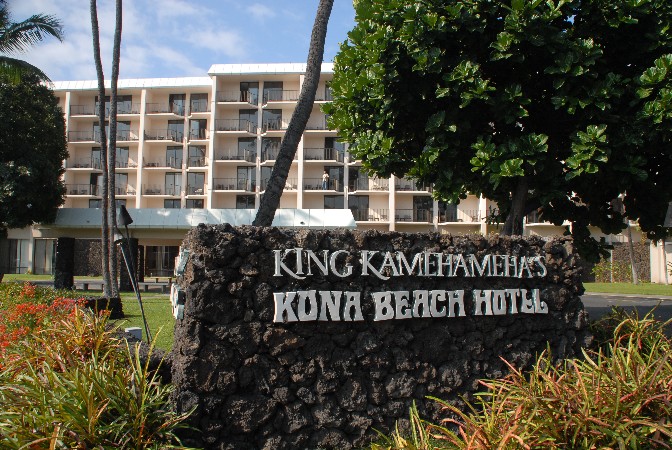
We hit the ABC store for some snacks and head up to our room. Kim and I have a view overlooking a roof that overlooks the small beach that the hotel has.
In the afternoon, we have signed up for dugout canoe trip? session? experience? Something like that:

We get the boat off the beach, get in, and head out of the little hotel harbor. We attempt to learn to paddle together as a team on one side of the boat, with limited success. We then learn how to paddle on alternate sides and how to switch our sides, also with limited success. Then we head back in, comfortable in the knowledge that, if circumstances ever put us in the seat of a competitive outrigger canoe race, we will be of little use whatsoever.
That night is “dinner on your own”, and the Gunnersons head out on their own to a local brewpub.
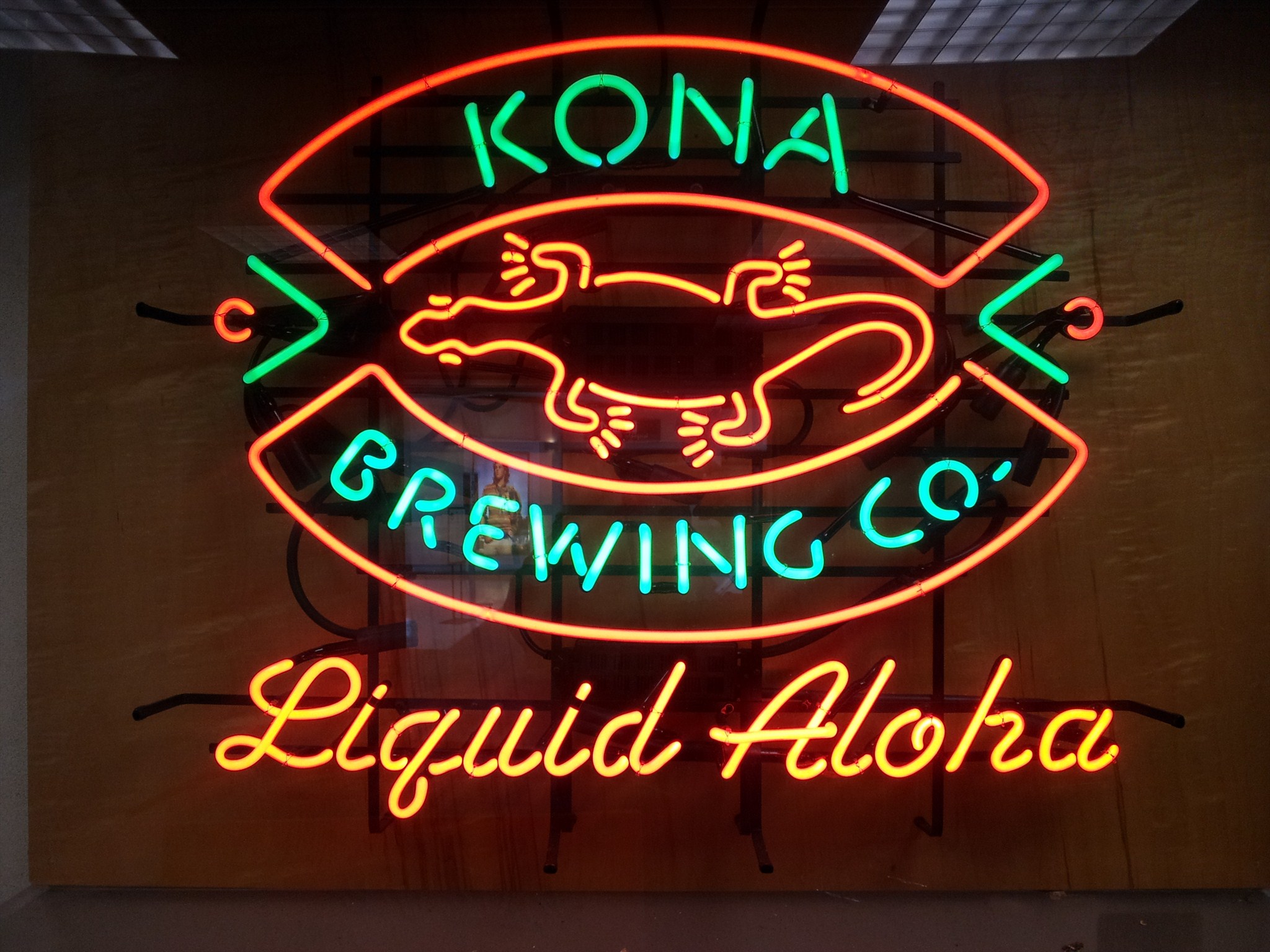
The service is good, and the food is good, but our enjoyable evening is interrupted by a gentleman – a gentleman named Guillermo, who has pushed some rain over to Kona. We move to another table, and, by the time we are done with our dinner, it has reduced to a light rain, the kind that Washingtonians such as us make a point of pride of walking in. The rest of the night is uneventful.
Day 4: Water day!
One of the reasons for travel is to expose you to new experiences, and you need to be paying attention or sometimes you may miss them. If you have your head buried in a book or are playing with your phone, you will miss out on natural wonders. This morning was one such instance; had I not been paying attention during breakfast, I would have missed seeing a young lady eat an entire dinner plate piled up with bacon – well in excess of 30 pieces by my estimation – followed by a dessert of fruit, bread, and another 10 pieces of bacon. I don’t think she weighed more than 100 pounds.
Today will be spent on the water. We start by getting into our water togs and vanning up for a short trip to Keauhou Bay. We are going kayaking and snorkeling today. All the kayaks hold two people, so we have already decided that Sam and I will be in one kayak and Kim will ride with somebody else. She ends up paired with Jim, who’s family thoughtfully brought along an extra child since Kim and I had the poor foresight to only have the one.
We have gone sea kayaking a few times in Puget Sound (and once in Alaska IIRC). The water there is cold, so you need a stable kayak that can keep you dry. One like this:

But, we’re kayaking in an area with warm water, so we end up with a kayak like this.

We are going to be snorkeling and swimming off of the kayaks, so our leaders give us a quick demonstration on how to get out of the kayak smoothly, and then how to get back into it. Getting out is all about the proper points of contact so you don’t rock the boat too much, and getting in is about swimming out and then rolling into the seat. Our leaders do this about as well as you would expect someone who does it a few thousand times a year.
We all have life jackets, though Sam and I have them deployed behind us to give us a little extra cushion. Sam has done a lot of swimming and loves the water, I suffered through lessons and a few years of swim team, and Kim grew up swimming in the surf in Key West so the hard part is getting her out of the water.
We launch from the dock and row out to a buoy in the bay to assemble the group before we head out. Kim and Jim decide that they want to practice the exit and entry procedure for the kayak; they do fine getting back into the boat but did not exit it in the approved manner.
And, it’s time to paddle. Sam is nice and consistent, and we settle into a steady rhythm. Except that the boat is consistently pulling to one side, so we have to paddle asymmetrically to get it back in line every minute or so. Unlike sea kayaks, these guys don’t have a rudder you can use to keep you on course, so it’s paddle for a couple of minutes, turn, paddle for a few more minutes, turn. With 9 boats doing this, it’s a bit of a comedy going out. We pause to regroup now and then. Along the way we run into a pod of dolphins – spinners, I believe – that cavort through our assemblage of boats.
Kim is having a horrible time:

Eventually, we reach our destination a bit down the coast. I believe it was near Kualunai point. The leaders anchor their kayaks and we all tie up to them, and then we get out to go snorkeling. I have my old Canon A20 in a waterproof housing (actually, it’s not my old camera – it’s my slightly-less-old camera since the old one suicided while snorkeling the last time we were in Maui), and Kim has her brand new Nikon waterproof Coolpix.

We swim around a bit. I do a few dives, but we are not equipped with fins, so I can’t get down more than about 10 or 15 feet or so, and to do so I thrash around enough that the fish just swim away. The snorkel is the old school kind (no valve), but that’s what I learned on so I’m okay. The mask, at least, is high quality; no leaks, and easy to equalize pressure in.
I had planned on showing some decent underwater shots here, but they’re mostly pretty bad, so I’m going to spare you the details.

After 30 minutes or so of swimming and diving, we group back at the boats to have some snax and cull the weak from the strong. You can see the weak up there.
I would, of course, have participated in this activity except that I’m wearing my contacts and would probably lose them. There could be no other reason I would avoid climbing a precipitous rock face and hurtling myself out into the void over some hard-looking water.
The young one does it:

The we circle the wagons, get everybody back in the canoes, and head back. This turns into a little bit of a race, which is fine, except that the boat keeps yawing to the port side (yeah, I’m gettin’ all nautical and stuff), so we have to stop paddling on the right pretty often. My left arm is significantly sorer at the end.
We eventually make it back near the dock, get careful instructions from our leaders about how to queue up so that we can get the kayaks out smoothly, which are then promptly forgotten by the majority of the boats as they rush for the ramp.
We finally disembark, grab our stuff, and head to rinse off in the outdoor shower. Nice to get the salt water off, a bit bracing as far as the temperature goes. Another quick change into normal clothes in another somewhat dodgy park restroom, and we head off to lunch.
Which is at Akule Supply, conveniently located a mere 25 steps away.

After the paddle and the swim I probably would have even eaten poi, but the food is good. IIRC, we had:
- French fries
- Deep-fried avocado with spicy sauce
- Chicken something
- Salad something something
I grab a Diet Coke from the cooler, and we sit around and talk until it’s time to go. We van a bit until we get to Kona Blue Sky Coffee.

At the plantation, we get to sample the different blends and learn more about how coffee is harvested, processed, and roasted. As a non-coffee-drinker, I am not paying a lot of attention, but I gather that there are elves involved.
We have another transit to do, this time to the Fairmont Orchid, so it’s back in the vans again, and we head out to the Fairmont, where we check in and chill until it’s time for dinner.
Dinner is at the Mauna Lani hotel just down the road a bit and their CanoeHouse (apparently spaces are rationed on this part of the island).

They have a large canoe hanging in the rafters so that you know that you are in the right place. I decide to skip the fish for a nice and have the rack of lamb; it is excellently presented, cooked to perfection, and utterly devoid of seasoning.
There is a bit of a pattern here – if you are in a resort, the food isn’t very good, and if you are outside the resort, the food is generally better.
But, it is a good night with good company.
Day 5: Waimea – Polulu Valley Lookout
This is the last day of riding. There are three different routes listed – a 9 (ish) mile route from the drop-off point to the lookout, an 18 mile route to the overlook and back, and then a 33-mile route out to the lookout and then back to Kawaihae for lunch.
The night before, the leaders offered the group the opportunity to ride from the hotel to the dropoff point, an extra 29 miles at the start of the day. I am the only one who raises my hand, and this means that I’ll be heading out at 7:30 in the morning. I get up early and put on my bike stuff and a lot of sunscreen, to try to avoid making my sunburn worse. A quick and light breakfast at the buffet (seems a waste to have a light breakfast at a big hotel buffet), and I meet Rob in the lobby, and we take a bit of a trek through the parking lot with me in my socks to where the van is parked. My bike is out and ready; I have decided to skip the tail trunk today because I expect it to be windy and I don’t want the extra drag.
I spin out of the hotel and turn left on Queen Ha’ahumanu Highway. The course that I am riding is part of the Kona ironman course, and I’m riding the last 29 miles to the turnaround point. As I get up to the next hotel, a couple of riders pull out in front of me. I’m sure one of them is a triathlete; he has aero bars and a water-bottle holder on the back of his seat. The second guy has a normal road bike. They are just getting started, so I pass them by and pick up my pace a little. The road is through lava fields, but it’s still pretty early and the weather is cool, so it’s okay. There is a slight sidewind coming down from the mountain.
At Waikui, I turn left onto Akone Pule HIghway, and the wind is now behind me. Unfortunately, there is a descent as well. That probably sounds like a weird thing to say, but that means that the descent won’t last long. Two minutes later, I’m back down by the water.
The cue sheet for this section, and I looked at the map the night before. It’s pretty straightforward except for when I get into Kawaihae, where it say “don’t take the turn to the Marina”.
I take the turn to the Marina.
I figure it out fairly quickly, and get back on the right road. During this excursion, the two riders that were behind me pass ahead. I slot in behind them and we keep riding. At the first hill, the second rider drops back, and I start talking with the first guy. He’s out training for a half-ironman that is coming up later this year. He warns me that the upcoming section is going to have some nasty sidewinds, and that there is a 4 mile climb up to Hawi. We ride together for a while, and then he stops to wait for his friend.
And wow, he was not kidding about the sidewinds. At times, the road is shielded by a hill cut, and then you come out to get hit by the sidewind. 20MPH is my guess. I ride for 10 miles over a bunch of rollers, and hit the base of the hill. I start up.
As a hill, it’s not very steep – my GPS says it’s only a couple of percent in inclination. But – and this is a big but – I’ve turned to the right, so the sidewind has turned into a headwind. It’s a nasty one. But, I know how to suffer, so I just keep climbing. At least the wind is keeping me cool. The view to the left is pretty nice, but it’s easy to get jaded after a week in Hawaii. After ten or fifteen minutes, the triathlete shows up and tell me his friend turned around, and he will be turning around in a little bit. He powers on ahead, and quickly pulls a U-turn to head back. At this point, the vans pass me.
The road has curved a bit more to the right, and now I’m headed directly into the wind. I climb, climb, and climb some more, and then finally top out in Hawi. The climb was about 5 miles, and only climbed about 500 feet.
I reach the vans just as everybody is getting ready to roll out. I refill my bottles and head out with the wife and offspring. My plan is to ride with them to the overlook, and then we’ll decide what to do from there. I get in the front to block the wind. The first section is mostly downhill, with a few intense uphill sections (one was a nice 20% grade). We keep riding until we get to the Pololu Valley Lookout, which is the same valley we looked at from the other side on the first day. We go and look – ho hum, another incredible view – and I stuff my face with some Maui onion potato chips to get some more salt into my system.

We turn around, Samantha decides to van back (or at least part of the way back), and Kim and I decide to ride back. Lara is going to ride with us.
As the morning has gone on, it’s gotten warmer and a bit more humid. It’s easier to ride with the headwind than the tailwind, but we have pretty much lost our cooling wind, so it’s getting a bit miserable. It takes us about 75 minutes to ride back to the drop-off point, which involves about 600’ of climbing. We are the back of the train right now, so we re-water and re-fuel and press on. We have 17 miles until lunch.
The first 5 miles – back down the hill – are great, kicking along at 25 MPH. That lasts about 15 minutes, and then it’s back to the rollers I rode through earlier, except this time the sidewind is mostly gone. It’s not too bad when we are out in the open, but when we get in the road cuts, the rocks (aka “lava”) are radiating heat, and it’s about 20 degrees hotter in those sections. After two water stops and about 300 hours more of riding, we get to Kohala Burger & Taco. I am well and truly cooked, but thankfully Kim says that she is done, so I don’t have to ride back to the hotel.
Strava, 62.8 miles, 4050’.

Pretty much everybody else has their food or is already done, so we head inside to place our order and cool off a bit. I drink two cups of ice water while we wait and then shotgun down a Diet Pepsi. Our tacos show up, and as we are sitting there eating, the first van loads up and heads back to the hotel. We finish our food (fish tacos, quite good, though my culinary requirements after that long on the bike are possibly a bit suspect), and Kim gets in line to get some shave ice. She finally gets to the front of the line, gets her ice, and we get into the delightfully cool van to head back to the hotel.
There’s a certain feeling after a hard ride when you get some real food in you, and we are feeling okay. As we pull out of Kawaihae, we notice some smoke to the right of us, which quickly resolves into a major brush fire.

The road that I rode from the hotel is closed and, as we watch, a bunch of emergency vehicles flee that area to come back towards us. We aren’t going to be able to get through on the road. But we have drinks and snax, so we’re fine. We head back the way we came and turn into a private gated development that climbs up the hill about 4000’. Then we turn and head towards Waimea, back south, and then – finally, back to the west and our hotel. That’s about 50 miles of driving to go 10 miles, but we didn’t have big plans for the afternoon and we had a great group in the car, so it was fun.
After removing 62 miles of volcanic grit off of my body, we get ready for our last dinner. We started with a reception at the bar near the pool. It is very strange to be having drinks with your daughter. And then we headed over to Brown’s Beach House Restaurant for our last dinner together.
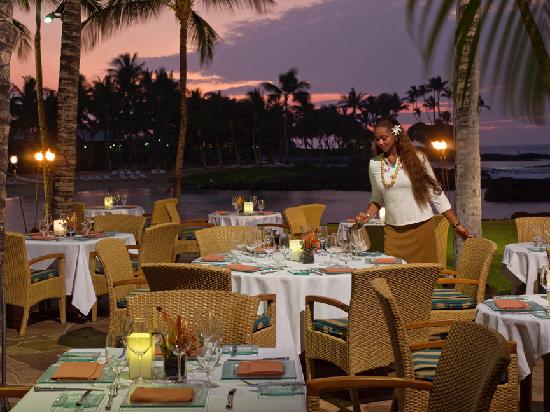
We had pretty much that exact view, on an out-of-the-way section of the seating area. Which was nice. After a bit, the appetizers came – I had some of the beef cheeks, which sounds like a great way to convert a cheap ingredient to a $18 appetizers. I ordered the Big Eye Tuna, a bit of specificity that I assure you will become important soon.
And then we talked. Either we didn’t look very hungry or they lost us, but we waited a very long time for our food to show up. And then they showed up with the plates but didn’t know who had ordered what, which isn’t great if you’re charging $40 a plate. Mine came back as “Ahi”, which is technically correct but more than a little confusing when there’s a server walking around asking who had the ahi.
By this time, the restaurant was empty, but we did have time for dessert before we headed for dinner. I’m actually a little tired of appetizers + entrée + dessert at dinner and am hoping for something simpler in the near future.
Day 6: Petroglyphs
This morning includes an optional historic activity, but the brush fires still have the road closed, so those of us who are left take a short hike to some nearby petroglyphs. It’s a nice trek over a golf course, along the beach, through a parking lot, and then back through a whole bunch of scrub forest.
When you get there, the petroglyphs do not look at all like these, which are recreations right next to the parking lot.

They look like this:

Then it was back to the hotel and into the van to head back to our original hotel, where we hung out, went to a food court for dinner, and watched the sunset. And then got up the next day and flew home.



















































